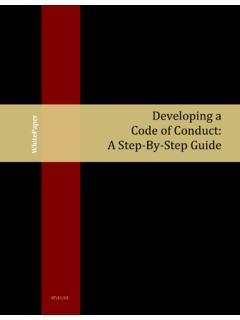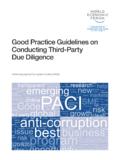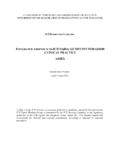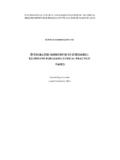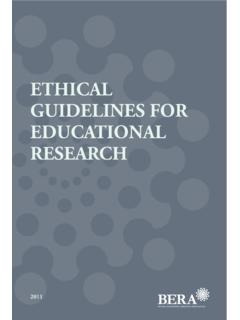Transcription of Best Practices on Handling an Ethics Report v2
1 Best Practices for Handlingan Ethics Hotline Report :Developing Policies and Proceduresfor conducting anEffective Ethics InvestigationWhitePaper 10/25/10 1 Table of Contents The First Step: Establishing an Ethical The Need for Stronger Ethical Standards Ethics Start at the Top Creating a Code of Developing the Code Implementing the Code The Corporate Ethics Officer An Essential Code Component: The Third-Party Ethics Hotline Beginning the Investigation: Preliminary 6 conducting a Full 7 Choosing the Investigator Proper Notification Preparation conducting the Interview Questions for the Complainant Questions for the Respondent Questions for the Witnesses Following Up Making the Remedies Final Report Additional Training Learning from the Incident Ethics Investigation.
2 13 Common Pitfalls to Lack of Timeliness Lack of Knowledge Poor Interviewing Techniques 2 Lack of Expertise Inconsistent Protocol Management Interference Evaluating the Best Practices on Display: Ethics Investigation Checklist 3 Best Practices for Handling an Ethics Hotline Report Developing Policies and Procedures for conducting an Effective Ethics Investigation Abstract An essential element in the long-term success strategy of any business organization is the development and implementation of a comprehensive Ethics and compliance program to reduce the possibility of potentially harmful unethical Practices in the workplace.
3 According to the Ethics Resource Center (ERC), a nonprofit organization that works to advance the practice of ethical behavior in both individuals and organizations, the goal of an Ethics and compliance program should be to help governing authorities, managers, employees, and agents work together to pursue the purpose of an organization and achieve its more specific goals and objectives in a manner consistent with its standards for ethical business conduct. Unfortunately, no matter how strong an organization s Ethics program is and how vigilant its approach to reducing unethical Practices , it is highly unlikely that ethical lapses can be eliminated completely.
4 According to the ERC-conducted 2009 National Business Ethics Survey (NBES), 49 percent of employees indicated they had witnessed unethical behavior in the workplace. One critical step employers should take to combat ethical violations in the workplace is to provide employees with access to a mechanism for reporting unethical behavior in confidence and without fear of retribution, typically in the form of a third-party Ethics hotline. Additionally, once a potential violation is reported, the organization must have a system in place to investigate the allegations swiftly, thoroughly and fairly.
5 49 percent of employees state they have witnessed an unethical act in the workplace Source: 2009 National Business Ethics Survey Ethics Resource Center 4 When establishing a system for investigating Ethics complaints, it is important that all processes and procedures adhere to best Practices . According to QFinance, a website that provides financial resources as well as corporate Ethics and governance guidance, a best practice can simply be defined as the most effective and efficient means of achieving any task. The purpose of this paper is to help organizations identify best Practices regarding Ethics investigations and how they can be developed and implemented for their own use.
6 Organizations can learn how establishing an ethical foundation that can lead to the creation of a stronger ethical culture. The paper will also outline the steps in an effective investigation and how to avoid potential pitfalls. A real world example of best Practices in corporate Ethics investigation policies and procedures will also be outlined. The First Step: Establishing an Ethical Foundation The Need for Stronger Ethical Standards The need for stronger corporate ethical standards gained momentum in the wake of scandals such as Enron and Tyco where top executives bilked their companies out of millions, and in some cases, billions of dollars.
7 As a result of the scandals, Congress passed the Sarbanes-Oxley Act of 2002 (SOX), a major piece of anti-fraud legislation governing corporate ethical Practices and compliance in publicly traded companies. As a result, best Practices in developing and enforcing Ethics policies and procedures not only became necessary for the financial survival of corporations, they also served to mitigate their financial exposure. In addition to new legislation, various scandals brought to light the notion that an organization cannot realistically expect employees to behave in an ethical manner unless it develops a strong ethical foundation that permeates the corporate culture.
8 If employees have the understanding that there is a policy of zero tolerance regarding ethical breaches and that offenders will face severe consequences, they may be less inclined to commit unethical acts. When employees do come across a questionable ethical situation, they must believe that the organization has strong policies in place to prevent retaliation against whistleblowers. Ethics Start at the Top A strong ethical cultural starts at the top and trickles down through the rest of the organization. As the 2009 NBES points out, organizations exhibiting strong ethical leadership from management reported a 40 percent rate of ethical misconduct as opposed to 77 percent in weaker ethical cultures.
9 A culture that promotes Ethics in the workplace can have a positive effect on employee morale. According to Andrew Sigler, former CEO of Champion International Corp., A good ( Ethics ) 5 program gives people the courage to do what they want to do. In essence, a strong ethical culture allows employees to feel good about the decisions they make. When attempting to create a strong ethical culture, top management should begin by assessing its current culture and policies as well as the nature of its business to see where Ethics issues have occurred in the past and could occur in the future.
10 For example, an accounting firm may need to tailor its Ethics policies more toward preventing financial fraud, where a company that receives work primarily through government contracts may need to pay close attention to potential conflicts of interest. Creating a Code of Ethics Developing the Code Once the organization determines its ethical needs and direction, the next step is to create a written policy for its employees to abide by. In many organizations, this will take the form of a code of Ethics , also known as a code of conduct. In essence, a code of Ethics is a set of standards and guidelines developed in accordance with the company s values.
